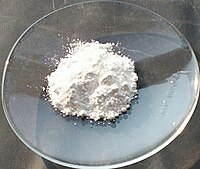
Photo from wikipedia
The paper introduces the development process of fiber-reinforced composite with increased resistance to elevated temperatures, which could be additionally increased by the hydrothermal curing. However, production of these composites is… Click to show full abstract
The paper introduces the development process of fiber-reinforced composite with increased resistance to elevated temperatures, which could be additionally increased by the hydrothermal curing. However, production of these composites is extremely energy intensive, and that is why the process of the design reflects environmental aspects by incorporation of waste material—fine ceramic powder applied as cement replacement. Studied composite materials consisted of the basalt aggregate, ceramic fibers applied up to 8% by volume, calcium-aluminous cement (CAC), ceramic powder up to 25% by mass (by 5%) as cement replacement, plasticizer, and water. All studied mixtures were subjected to thermal loading on three thermal levels: 105°C, 600°C, and 1000°C. Experimental assessment was performed in terms of both initial and residual material properties; flow test of fresh mixtures, bulk density, compressive strength, flexural strength, fracture energy, and dynamic modulus of elasticity were investigated to find out an optimal dosage of ceramic fibers. Resulting set of composites containing 4% of ceramic fibers with various modifications by ceramic powder was cured under specific hydrothermal condition and again subjected to elevated temperatures. One of the most valuable benefits of additional hydrothermal curing of the composites lies in the higher residual mechanical properties, what allows successful utilization of cured composite as a thermal barrier in civil engineering. Mixtures containing ceramic powder as cement substitute exhibited after hydrothermal curing increase of residual flexural strength about 35%; on the other hand, pure mixture exhibited increase up to 10% even higher absolute values.
Journal Title: Advances in Civil Engineering
Year Published: 2018
Link to full text (if available)
Share on Social Media: Sign Up to like & get
recommendations!